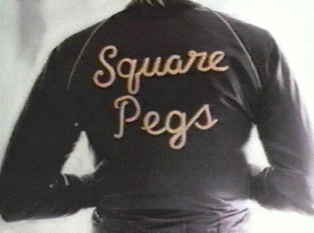
Anyone who has spoken with me in the past month knows that I am not a fan of synchronous remote teaching. Beyond the basic belief that teaching in the classroom and teaching online are two radically different pedagogies (in other words, A ≠ B (in other words, "You can't fit a square peg into a round hole")), there is the greater problem of imposed pedagogy -- requiring faculty to teach in a specific way rather than empowering them to teach in the way they think best. Moreover, the use of Zoom and other teleconferencing systems as a means of achieving that required synchrony have raised other concerns, such as the unfortunately named zoombombing, wherein bad actors disrupt the virtual classroom, often with hate speech, and the as yet unnamed problem of invading our students privacy.
Despite all that, I have done my best to follow the expectation to meet online with my classes according to the original class schedule, and to be honest, many of those meetings have not gone well, in part because getting students to engage in a large-group synchronous discussion online is even more difficult than getting them to do so in person. I find they are more willing to do small group discussions, using Zoom's Breakout Rooms function (here's a quick tutorial on setting up Breakout Rooms), but I have learned over the years that while consistency in teaching is good, redundancy in teaching is not good. So, I've been trying to find ways to run my classes that give them work that both challenges them but that keeps them connected to the actual class.

One of the classes I'm teaching this semester is called Dystopias, Real & Imagined (I think I deserve some kind of award for that level of prescience, to be honest), so for the past six weeks, I've been able to do a lot more just-in-time teaching than I had anticipated. Last weekend, I came across a video interview with Edward Snowden talking about the risks to civil liberties that come with the COVID-19 pandemic. Under normal circumstances, I would have posted the link to Brightspace and told the students to watch it on their own before Thursday's class, since under those normal circumstances, I don't like using class time to deliver content. Given our current circumstances, I thought about using Zoom's screen sharing function to watch the video together during class, but I've seen other people try this, and the video usually ends up being unwatchable (choppy audio and such).
So I did what I often find myself doing and borrowed an idea from my wife, who teaches high school English. Since going remote at her school, she has been using EdPuzzle, a site that lets you create assignments by embedding videos and inserting questions and commentary at specific points during the video. While this can be used to simply test understanding/attention (by asking a simple multiple choice question about something that was just said in the video), they can also be used to encourage/demonstrate critical thinking and to prepare students for a post-video discussion.
Active Listening
At one point in the video, Snowden starts to talk about the expanded surveillance powers the federal government gave itself after 9/11. Before he does so, I inserted a multiple choice question that asked students when they thought those emergency powers were retracted. After they answered the question, the video resumed, and Snowden gave them the correct answer. (Take a look at the screen shot below for the answer.)


At another point, Snowden explains how our cellphones are being used to analyze social distancing at the local level. Here I paused the video and gave the students a more complex task by asking them to use Unacast's Social Distancing Scoreboard, a site that uses the data Snowden discusses in the video, to look up the county in which they are currently living. Although the text box seems small, it expands with whatever the students type. A few of my students wrote short essays on why they think their home counties are getting such bad grades for social distancing.
One of the best functions of EdPuzzle is that you can prevent students from skipping ahead or even going backwards, so in order to answer these questions, they had to watch the entire 22-minute video. While this is a useful way to monitor student engagement, it's also, I think a way to make the task more transparent -- the system makes it impossible for the student to misunderstand what is being asked of them. Moreover, EdPuzzle tracks everything they do with the video -- when they started it, how much of it they watched. For the MC questions, EdPuzzle will automatically grade them; whereas for the open-ended questions, I went through after class and read each one and awarded the points.
To be honest, I was hesitant to use this. The interface for EdPuzzle is clearly designed for grade school teachers, as are many of the settings (EdPuzzle integrates very well with Google Classroom, but not at all with Brightspace). Also, sometimes my students get frustrated with my attempts to trick them into learning more actively. Two things convinced me I was wrong to worry though. First, about a third of my students, without any prompting, told me how much they enjoyed this activity.
this is a really cool activity
Second, once everyone was done with the video (after probably about 40 minutes, since some wrote really long answers), we had the best discussion we've had since going remote. Both these things really moved me. I don't know about you, but this past week, the students have really seemed to sink deeper into the malaise they've been in since going remote. They've been a lot less engaged, so it was great to see that must natural positivity coming through the screen.